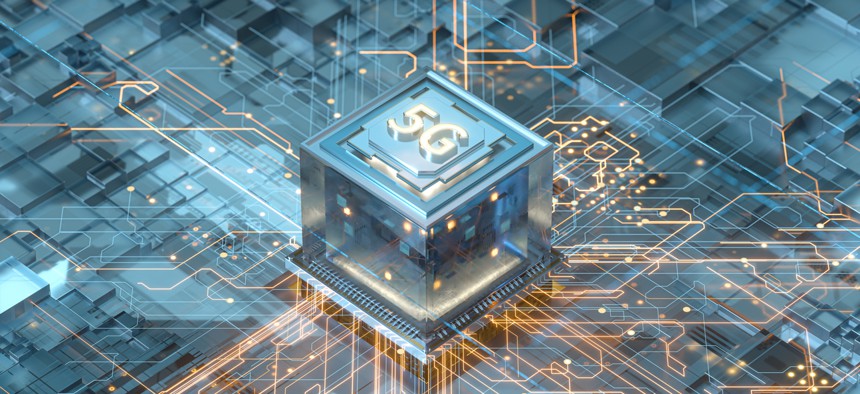The Future of 5G: Not There Yet, But Getting Closer, Officials Say

Jian Fan/istockphoto
There are several areas where 5G capabilities can improve, including bandwidth potential.
For several years now, the telecommunications industry has been promoting 5G and its immense potential to turbocharge business and citizen activities. During the Nextgov 5G Futures virtual conference on Dec. 2, a couple of experts discussed where 5G technology is today and unresolved issues it raises in the national security arena.
The National Science Foundation has been deeply involved in understanding the technical and implementation issues raised during 5G development. Dr. Thyaga Nandagopal, the acting Deputy Division Director of the Computer and Network Systems Division, part of NSF’s Computer and Information Science and Engineering Directorate, acknowledged 5G has yet to meet expectations.
“You start out to do something not knowing how hard it’s going to be,” he said, but “come along with us on this journey. We’ll get you there. But even if you only get halfway there you’ve still got” something better than it was.
For example, he said, “in 2015 or 2016, I went on a road trip and was disconnected most of the trip. I just did a road trip and my kids were connected to Netflix the whole time.”
There are three primary areas where 5G promises improvements—higher bandwidths, very low latencies, and much greater density of connections (how many user devices could be handled). Nandagopal outlined the progress made in each area, how they are connected, and what is left to do.
Bandwidth is about spectrum. “The more spectrum you have, the more you can use,” he said. “The FCC has been working to free up spectrum.” While 5G has been deployed in many urban areas, it is not yet available across the country.
The goal has been to get to a 10x gain in bandwidth. “I think we’re easily at 5x,” he said. “I don’t know if we’re at one gigabyte per second yet. Maybe in some places, [but] it’s getting close.”
Nandagopal described latency—the lag between sending data and receiving it—as “the linchpin for the killer applications we’d like to see.” He said it may take five to six years before this gets reduced to 10 milliseconds. “I think we’re getting to 20 milliseconds, down from 100, but we need the 10 for real-time” applications such as virtual reality. While VR is available now, the lag can make users queasy because of the gap, he noted. “Coming from 100 to 20 was mostly engineering … but [from 20 to 10] requires a new way of thinking.”
This is where the relationship between bandwidth and latency is important. “You can always improve latency by compromising on throughput,” he pointed out.
As for the density of connections, “there the story is like latency. We’ve made a lot of progress,” Nandagopal said. “The real practical implication is power … Once we are able to solve that, we’re going to see that so-called explosion [of new applications], because that will support a smart monitoring system across a city, [for instance] and provide feedback on processing information. To solve that we need to solve the power issue. We can have devices today that survive for 10 years, but we want devices that will last for 30 or 40 years.”
While Nandagopal may be sanguine about solving the technical hurdles, the national security obstacles are just as real but much more amorphous.
The national security implications of 5G “are really a lot broader than normal national security implications,” said Laura Bate, Senior Director, Task Force 3, Cyberspace Solarium Commission. “There are three different categories.”
First are “security risks, simply compromised communications systems. There’s the more nefarious side, deliberately introducing a vulnerability;” since communications is a critical infrastructure, a deliberate attack can have “watershed effects,” such as finding ways to sustain the financial sector, where communications play an integral role.
And there are more abstract security issues. “We’re talking about the proliferation of surveillance systems,” Bate said. “In the big picture, the future of the internet drives in the direction of what these [5G] technologies look like.
The second national security concern is “the availability of 5G components [and] the supply chain issues here,” she said. “A huge amount of the production of semiconductors comes from East Asia–it could be cut off. The same for China.”
The third national security concern is the ongoing competitiveness of U.S. telecom companies and manufacturers of key components, Bate said. “If trusted manufacturers of 5G components are driven out of the market, we have even less availability … the U.S. government has an incentive to ensure our 5G [providers] can continue.”
She referenced the Creating Helpful Incentives to Produce Semiconductors for America (CHIPS) Act, passed as part of the National Defense Authorization Act of 2021, but not yet funded. “There’s a lot going on there legislatively that we’re hoping to see move forward this year.”
She said the U.S. Innovation and Competition Act, or USICA, would fund the CHIPS Act. “There [also] are provisions in USICA that would promote standards in training, partner engagement, things like that. The problem is, how do you promote” the values of the United States “without it being seen as political? It should be based on sound science.”
Bate suggested that companies who play a central role in the U.S. economy should be supporting open, interoperable standards and not supporting totalitarianism.
She cited China’s recent actions in different international organizations that play a role in setting those standards. When the 5G technology standards were being set in 2016, “Lenovo voted for [one standard promoted by the U.S.] and got a huge amount of criticism for being disloyal to China,” she said. “In the next round it voted for the Chinese proposal for the sake of patriotism and protecting its national interests.”
Bate said one potential risk from this kind of nationalistic action is that “China, or any country, can patent a technology, push that as the standard, reap the profits,” and dominate competitors, including American companies. “You get this sort of cyclical tendency” that is self-reinforcing.
NEXT STORY: Quick Hits






